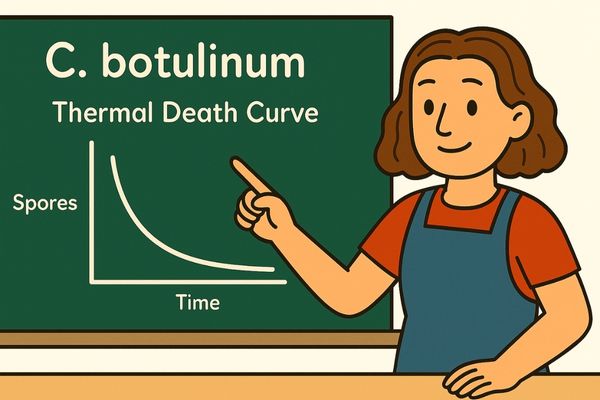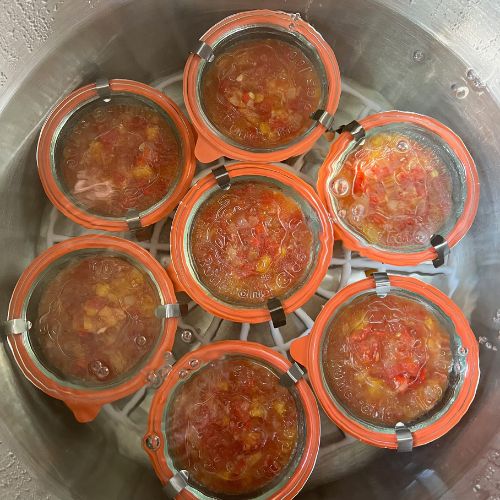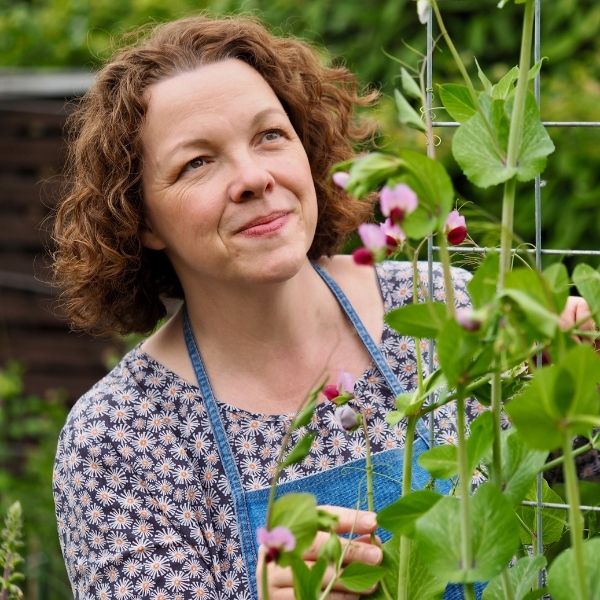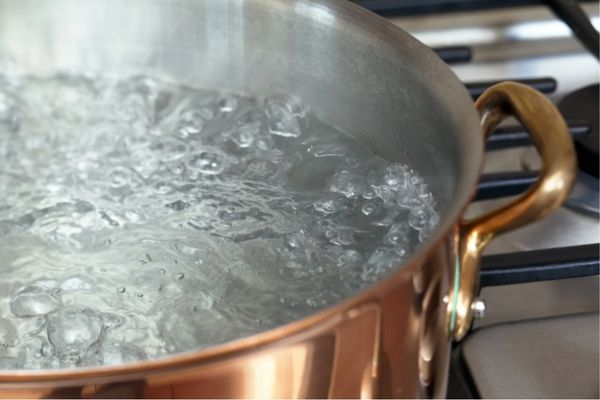Think boiling water can’t kill Clostridium botulinum spores? Think again. This myth has shaped home canning advice for decades – but is it true? In this post, I unpack the science behind a persistent question: does boiling kill botulism spores? The answer is more nuanced than most safety guides suggest.
- Does boiling kill botulism spores?
- What are lethality tables and why are they important?
- Did you know?
- Canning safely without a pressure canner
- Why the 12D industrial sterilization standard isn’t needed for home canning
- How long should you boil low-acid foods to kill Clostridium botulinum spores?
- USDA guidance on boiling times for low-acid foods
- Is water bath canning dangerous? Not if you do this
- Why water bath canning is a safe and proven method for low-acid foods
We’ve all heard it a thousand times: “Botulism spores can’t be killed at boiling temperature.”
This idea is everywhere – in internet forums, canning groups, and even official safety guidelines. But here’s the truth – it’s misleading.
Yes, Clostridium botulinum spores are heat resistant and can survive short boiling times. However, saying they can’t be killed at 100°C (212°F) is not accurate. Multiple food safety textbooks, a comprehensive 2014 meta-analysis, and even USDA resources acknowledge that C. botulinum spores are inactivated at boiling temperatures – it just takes longer.
What are lethality tables and why are they important?
A lethality table (also called a thermal death time table) shows how long it takes at a given temperature to reduce a population of microorganisms by a certain amount. These tables help food scientists and processors determine how long food must be heated to ensure it’s microbiologically safe.
Multiple textbooks on heat-based food preservation include lethality tables specifically for Clostridium botulinum: Heiss and Eichner (1) provide values starting at 90°C (194°F), while Hartwig et al. (2) and Moss and Adams (3) begin at 100°C. Together, they make one thing clear: C. botulinum spores can be inactivated at 100°C – and even below – if given enough time.
Diao et al. (4) analyzed more than 900 data points from 38 studies on how C. botulinum and its surrogate respond to heat. Instead of testing just one strain under one condition, they combined results from many different experiments – covering a wide range of strains and temperatures from 100°C (212°F) to 140°C (284°F). That matters, because this kind of meta-analysis helps us see the bigger picture: how spores behave on average across many realistic scenarios.
For home canners using boiling water, this is critical. While 121°C (as used in pressure canning) kills spores quickly, 100°C is still effective – it just takes more time.
Canning safely without a pressure canner
What Is a D-value and the 12D sterilization standard? In food microbiology, a D-value represents the time needed at a specific temperature to reduce a microbial population by 90% – that is, one logarithmic cycle (5,6). D-values are the foundation of lethality tables, which help determine how long food must be heated to reduce the number of spores or bacteria to safe levels.
For example, for Clostridium botulinum spores, the industry-accepted D-value at 121°C (250°F) is about 0.21 minutes (12.6 seconds). This means that every 12.6 seconds at this temperature kills 90% of the spores present. After one D-value, 90% are gone; after two D-values (25.2 seconds), 99% are gone; after three D-values (37.8 seconds), 99.9% are gone; and after four D-values (50.4 seconds), 99.99% are gone. This cumulative effect corresponds to a 4D reduction.
The 12D standard widely used in industrial food processing (especially for low-acid canned foods) means multiplying the D-value by 12 to achieve a 99.9999999999% reduction in C. botulinum spores – effectively reducing a theoretical population of one trillion spores to less than one viable spore, ensuring sterility even under worst-case conditions.
To make “one trillion” more tangible: it’s one million million spores – an astronomically large number far beyond what home canners encounter.
Industrial canning has to account for many variables:
- Massive batch sizes
- Unwashed produce
- Unknown handling
- Global distribution without refrigeration
The 12D standard builds an immense safety margin, which is critical in commercial contexts – but not necessary for home kitchens.
Why the 12D industrial sterilization standard isn’t needed for home canning
You’re not starting with a trillion spores. You work with small batches, fresh produce, clean jars, and basic hygiene.
Many home canners blanch or partially cook food before canning, which already starts reducing spore loads. After processing, you observe your jars, check seals, and discard anything suspicious.
Given these conditions, a 12D industrial sterilization process isn’t needed – especially since any jar that shows signs of spoilage is simply thrown out.
How long should you boil low-acid foods to kill Clostridium botulinum spores?

By now, you’ve seen that pressure canning isn’t the only way to inactivate Clostridium botulinum spores. They’re not invincible at 100°C – it just takes more time. This is exactly why traditional German water bath canning recipes recommend boiling low-acid foods 120 minutes.
So how do we know those long boiling times are enough?
This is where D-values and L-values come in. Using the published lethality values, we can compare how effective 100°C is compared to 121°C – and figure out how long you’d need to boil something at 100°C to reach a meaningful level of safety.
Let’s walk through the math.
Step 1: Understand the reference values
- At 121°C, the D-value for C. botulinum is about 0.21 minutes.
→ That means every 0.21 minutes (or 12.6 seconds) at 121°C kills 90% of the spores. - At 100°C, the L-value is 0.008.
→ That means 100°C is 0.8% as lethal per minute as 121°C, or 125 times less effective.
Step 2: Decide on a reasonable target
Let’s say you’re aiming for a 4D reduction – enough to kill 99.99% of spores. That’s a solid goal for clean, home-prepared food.
- 4D × 0.21 minutes = 0.84 minutes at 121°C
Step 3: Adjust for boiling temperature
Now, convert that equivalent to 100°C using the L-value:
- 0.84 ÷ 0.008 = 105 minutes at 100°C
You’d need to boil low-acid food for about 1 hour and 45 minutes at 100°C to reach a 4D reduction.
That lines up remarkably well with traditional German boiling times of 90 to 120 minutes and shows that these recipes aren’t based on guesswork. They reflect real, measurable microbial inactivation.
For a broader look at how traditional German water bath canning works – and why it’s still relevant – check out What You Need to Know About German Water Bath Canning.
USDA guidance on boiling times for low-acid foods
The USDA acknowledges that Clostridium botulinum spores can be inactivated by boiling water but claim that the process takes hours – from 7 to 11 hours for low-acid vegetables (7).
Their recommendations likely incorporate extra safety margins for commercial-scale processing, variable produce contamination, and other factors not relevant in home settings.
However, their cited times are not consistent with published thermal death data and they don’t provide any clear references, suggesting a conservative, precautionary approach rather than a scientifically exact figure. (I have theory about where they get their numbers, but that’s a topic for another post.)
Is water bath canning dangerous? Not if you do this
Many sources caution against using boiling water for low-acid foods – but those warnings often ignore the real-world conditions of home canning. When you use clean jars, fresh ingredients, and boil long enough, traditional water bath methods can effectively inactivate Clostridium botulinum spores.
The key isn’t pressure – it’s time and temperature. And the math backs it up.
Why water bath canning is a safe and proven method for low-acid foods

What can we learn from all this?
No, you don’t need a pressure canner to safely preserve your green beans. And no, Clostridium botulinumspores don’t survive boiling water forever.
Home water bath canning is safe for low-acid foods when paired with:
- Clean starting materials
- Long enough boiling times
- Spoilage checks after sealing
- A realistic understanding of actual risk
You’re not trying to duplicate industrial sterilization. You’re using a system grounded in science and refined through generations of practice – and it works.
Find out how the Seven Layers of Safety make the German water bath method reliable for home kitchens – when used correctly.
References
- Heiss R, Eichner K. Haltbarmachen von Lebensmitteln Chemische, Physikalische Und Mikrobiologische Grundlagen Der Verfahren. 1st ed. Springer; 1984.
- Hartwig G, von der Linden H, Skrobisch HP. Grundlagen Der Thermischen Konservierung. Behr; 2009.
- Adams M, Moss M. Food Microbiology. New Age International Publishers; 2007.
- Diao MM, André S, Membré JM. Meta-analysis of D-values of proteolytic clostridium botulinum and its surrogate strain Clostridium sporogenes PA 3679. Int J Food Microbiol. 2014;174:23-30. https://doi.org/10.1016/j.ijfoodmicro.2013.12.029
- Den Besten HMW, Wells-Bennik MHJ, Zwietering MH. Natural diversity in heat resistance of bacteria and bacterial spores: Impact on food safety and quality. Annu Rev Food Sci Technol. 2018;9:383-410. https://doi.org/10.1146/annurev-food-030117-012808
- Ceylan E, Amezquita A, Anderson N, et al. Guidance on validation of lethal control measures for foodborne pathogens in foods. Compr Rev Food Sci Food Saf. 2021;20(3):2825-2881. https://doi.org/10.1111/1541-4337.12746
- United States Department of Agriculture, National Institute of Food and Agriculture. Complete Guide to Principles of Home Canning.; 2015. Accessed May 21, 2025. https://nchfp.uga.edu/papers/guide/GUIDE01_HomeCan_rev0715.pdf

Julie is a biologist turned science writer living in Germany. She shares her passion for traditional German water bath canning, seasonal cooking, and gardening on Old World Preserves.

